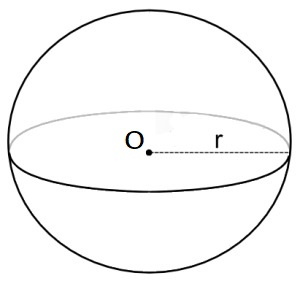Calculate the volume of the Sphere, surface area of the Sphere and know the formulas.
Sphere Calculator
Result:
| Radius: | 0 |
| Volume: | 0 |
| Surface Area: | 0 |
What is a Sphere?
A sphere is a round solid in three-dimensional space. Like a circle in a two-dimensional space, a sphere is mathematically defined as the set of points which are the same distance ‘r’ from a specific point in three-dimensional space.

The distance ‘r’ is called the radius of the sphere. It is the distance from a given point which is the centre of the sphere. The longest straight line in the sphere passes through the centre and connects two points on the boundary of the sphere. This line is called the diameter and it is twice the radius. The figure below shows a sphere of radius r and centre O.
A sphere has only a curved surface, there are no edges, vertices or faces. It is a perfectly symmetrical body.
In three-dimensional geometry, the equation of a sphere is $$ (x-a)^2 + (y-b)^2 + (z-c)^2 = r^2 $$
where (a, b, c) indicates the coordinates of the centre of the sphere in the x, y and z axes respectively, and r is the radius.
Properties of Sphere
Given below are some properties of a sphere.
Volume – This is the total space occupied by the sphere in three-dimensional space.
Surface area – Surface area is the total area covered by the surface of the sphere.
Diameter – This is the longest line in the sphere. It passes through the centre and connects two points on the boundary of the sphere. The diameter is twice the length of the radius.
Sphere formulas
Given below are the formulas to calculate different properties of a sphere.
| Volume | $$ {4\over3}πr^3 \;cubic \,units $$ |
| Surface area | $$ {4\over3}πr^2 \; square \;units \;$$ |
| Diameter | $$ 2r \;units \;$$ |
Characteristics of a Sphere
Given below are the main characteristics of a sphere.
Areas of application
Spheres occur frequently in everyday life. Some examples are as follows:
We now consider some examples making use of the sphere formulas.
Question: A sphere has radius 4 cm. Find the volume, surface area, and length of the diameter.
Answer: Here, the radius r = 4 cm
The diameter = 2r = 8 cm.
Volume of the sphere = 4/3 πr3 cm3 = 4/3 π(4)3 cm3 = 268.08 cm3
Surface area = 4/3 πr2 cm2 = 4/3 π(4)2 cm2 = 67.02 cm2
Question: The volume of a spherical ball is 5000 cm3. What is the radius of the ball?
Answer: The volume of a sphere is V = 4/3 πr3 cm3
So, the radius can be computed from the volume using the following formula
$$ r \;= \; \sqrt[3]{3V\over4π} \;= \; \sqrt[3]{3(5000)\over4π} \;= \; \sqrt[3]{1193.662} \;≈ \; 10.61 \;cm $$
Hence, the radius of the spherical ball is nearly 10.61 cm.

